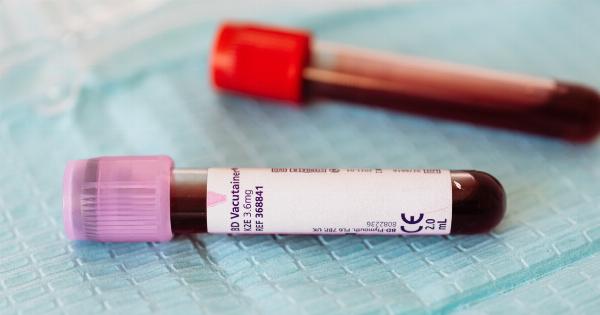Skin cancer is the most common type of cancer worldwide, with millions of individuals being diagnosed each year. Early detection of skin cancer is crucial for successful treatment and survival rates.
Researchers have recently developed a groundbreaking blood test that promises to revolutionize the screening and diagnosis of skin cancer. This innovative test could provide a non-invasive and quick method to detect skin cancer at its earliest stages, saving countless lives and improving patient outcomes.
The Importance of Early Detection in Skin Cancer
Early detection plays a pivotal role in the treatment and management of any type of cancer, and skin cancer is no exception. If diagnosed at an early stage, skin cancer has a higher chance of being cured successfully.
However, if left undetected and untreated, skin cancer can spread to other parts of the body, leading to a decreased chance of survival.
Traditional methods of diagnosing skin cancer rely on invasive techniques such as biopsies, which involve the removal of a tissue sample for examination under a microscope.
These procedures can be uncomfortable, time-consuming, and may cause scarring or other complications.
The Breakthrough Blood Test
The new blood test for skin cancer is based on the detection of specific genetic mutations and tumor biomarkers associated with skin cancer.
It utilizes advanced molecular techniques to analyze a patient’s blood sample for the presence of these indicators. This non-invasive method promises to eliminate the need for invasive biopsies and provide a faster and more accurate diagnosis.
How Does the Blood Test Work?
The blood test detects circulating tumor DNA (ctDNA), which is genetic material released by cancer cells into the bloodstream.
By analyzing this ctDNA, scientists can identify specific genetic mutations and alterations that are characteristic of skin cancer cells. The presence of these mutations in the blood can serve as a reliable indicator of the presence and progression of skin cancer.
The blood test works by isolating and amplifying the ctDNA using specialized laboratory techniques. The amplified genetic material is then sequenced and analyzed to identify any abnormalities or mutations associated with skin cancer.
The entire process can be completed relatively quickly, providing patients and doctors with timely results.
Advantages of the Blood Test
The groundbreaking blood test offers several advantages over traditional methods of diagnosing skin cancer:.
- Non-Invasive: Unlike biopsies that require cutting or removal of skin tissue, the blood test simply requires a blood sample, making it a painless and non-invasive procedure.
- Early Detection: The blood test can detect skin cancer at its earliest stages by identifying circulating tumor DNA, allowing for prompt intervention and treatment.
- Accessibility: The blood test can be easily administered in a doctor’s office or a laboratory, making it readily accessible to patients and healthcare providers.
- Quick Results: The test provides rapid results, enabling physicians to make timely decisions regarding treatment plans and patient management.
- Monitoring Treatment Efficacy: The blood test can be used to monitor the response to treatment and detect any signs of recurrence or metastasis, allowing for personalized and targeted therapies.
Promising Results and Future Implications
The initial studies and trials conducted on the blood test for skin cancer have shown promising results.
The test has demonstrated high sensitivity and specificity in detecting various types of skin cancer, including melanoma, basal cell carcinoma, and squamous cell carcinoma.
Additionally, the blood test has the potential to detect skin cancer at an earlier stage than visual examination alone, which can significantly improve patient outcomes.
Early detection means that patients can receive timely and appropriate treatment, increasing their chances of survival and minimizing the need for more aggressive interventions.
The introduction of the blood test may also reduce the burden on healthcare systems by streamlining the diagnostic process and reducing the number of unnecessary biopsies.
Furthermore, the accessibility and simplicity of the blood test may encourage more individuals to undergo routine skin cancer screenings, leading to earlier detection and reduced mortality rates.
Challenges and Further Research
While the blood test shows tremendous promise in the early detection and screening of skin cancer, there are still challenges to address and further research to be done:.
- Cost-Effectiveness: Currently, the blood test for skin cancer may present higher costs compared to traditional methods. Ongoing research is needed to optimize the test’s efficiency and reduce its economic impact on patients and healthcare systems.
- Standardization and Validation: The blood test requires further standardization and validation to ensure its accuracy and reliability across different populations and skin cancer types. Collaborative efforts among researchers and regulatory authorities are essential to establish standardized testing protocols.
- Combination with Existing Diagnostic Techniques: To maximize the benefits of the blood test, further studies may investigate its integration with existing diagnostic techniques, such as visual examination and imaging methods, to provide a comprehensive and multi-modal approach to skin cancer detection.
- Long-Term Monitoring: Long-term studies are needed to assess the blood test’s effectiveness in monitoring treatment responses, predicting disease recurrence, and guiding therapeutic decision-making.
Conclusion
The development of a groundbreaking blood test for skin cancer holds great promise for improving early detection and diagnosis. This non-invasive method has the potential to revolutionize the way skin cancer is screened, diagnosed, and treated.
Implementation of the blood test may lead to better patient outcomes, reduced healthcare costs, and ultimately contribute to minimizing the impact of skin cancer worldwide.





























